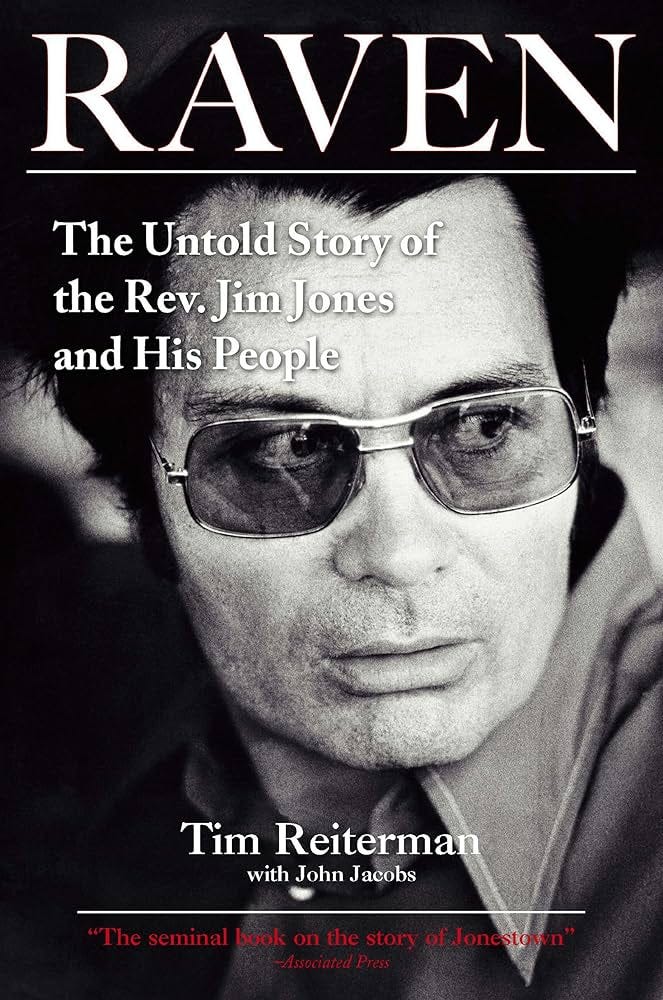Raven, Tim Reiterman (1982)
Raven, Tim Reiterman (1982) This is an epic book and and epic work of research that tells an epic story: the life of Jim Jones and his church, the Peoples’ Temple, from Jones’s birth in 1930s Indiana to the gruesome mass murder-suicide at Jonestown in November 1978.
Reiterman writes powerfully in the Preface of how the book came to be: he was present as a San Francisco Examiner correspondent at the Port Kaituma airstrip when Congressman Leo Ryan and three others were gunned down and Reiterman and nine others were wounded. That massacre preceded and triggered the far greater massacre at Jonestown the following day. While recovering from his wounds, Reiterman received numerous offers to do quick books capitalizing on the event’s notoriety; instead he resolved to tell the full and complete story in a way respectful to all participants including Jones, his collaborators, and his victims. The result is a work that shows the power of a deeply and comprehensively researched story, simply told.
Not that there is anything simple about the Jonestown story; the church Jones founded was, at various times and in various ways, a Pentecostal sect, a socialist Utopian community, an idealistic experiment in racial equality, and a cruel cult of manipulation and control. Reiterman, as a journalist, privileges narration and facts over interpretation; he rarely ponders the interpretive question of “what” the Peoples’ Temple was, much less its significance in the broader history and culture of its time and place. What he does instead is masterfully synthesize eyewitness and participant accounts, from inside and outside the Temple, as well as the voluminous records left by the Temple itself, to create a nuanced portrait of an organization evolving over twenty-plus years, and at its heart the disturbing and enigmatic figure of Jim Jones.
Jones, Reiterman contends (and I believe him), had good and bad in him from the start. Certainly the bad - a powerful urge to control, manipulate, dominate other humans, a sociopathic urge to lie, and a powerful paranoia, eventually combined with drug addiction, with which he also infected his collective, isolated community - outweighed the good, especially in the end, obviously, but really from the very beginning. In fact the “good” in Jim Jones, primarily his race egalitarianism, was, similar to the way I see the “good” in John Brown, another violent racial egalitarian, ultimately merely a very powerful, ennobling excuse or justification for doing terrible things that destroyed human lives. Another way to look at it is, there was “good” in Jones only insofar as, being a sociopath, he could do a reasonable impersonation of goodness when it suited his purposes to do so - which is not really Goodness at all.
Although Reiterman, while centering Jones and his family, depicts a large cast of participants and juggles the viewpoints of Temple loyalists, defectors, concerned relatives, journalists, and politicians both in the US and, later, Guyana - I couldn’t help wondering, by the end, whether there was a perspective of ordinary rank-and-file Temple adherents that wasn’t being adequately considered. These several thousand people, in California and eventually in Jonestown, mostly Black, many poor, gave all they had to support a community and a church that often abused and manipulated them in return. But they sincerely loved and even worshiped Jones and considered themselves among the most fortunate on earth to have found their place in his orbit. What were they getting? And how, to ask the biggest and most difficult question, did they find themselves in a mental and spiritual place, by late 1978, where mass suicide and murder seemed the logical next step? Reiterman speculates briefly on this but doesn’t really have the sources to answer; perhaps it is to a large extent unknowable.
In any case, Raven is a powerful and comprehensive study of a story and topic that has interested me since it first appalled me as a twelve year old child. The Jonestown story has a lot to say to us, not just about charisma and cults and human control but also, among other things, about the spiritual crisis of America in the 1970s and how it created the world we live in today. (Read early June, 2024)




